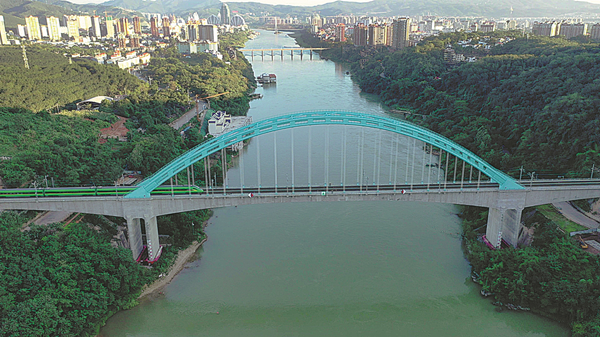
A train crosses a bridge on the China-Laos Railway in Yunnan province. [Photo/China Daily]
Laotian Thepmoukda used to travel between Vientiane, the capital of Laos, and Boten, a city that borders China, for business by car. "The trip took several hours. The road was slippery, especially during the monsoon, and some sections were even not built with asphalt, but with mud," the 27-year-old woman said, adding that she usually prayed onboard with the Zen gesture for herself and other passengers. "Some sections wind through the mountains. I was afraid when I traveled by car, especially on foggy and rainy days."
But since the opening of the cross-border railway linking China and Laos in December, Thepmoukda feels better about the journey. The first ride Thepmoukda took on the train was when she traveled back from Boten to Vientiane. She said it reminded her of her university days, when she used to travel around China during school breaks while studying in Shanghai.
"Most importantly, it is safe. It only takes about three hours, half the time it used to take by car," she said. "Many of my family members and friends had never traveled by train before, and some had never even seen a train. The opening of the China-Laos Railway has given many Laotian people like them the opportunity to experience this historic infrastructure firsthand."
The 1,035-kilometer line runs between Kunming, the capital of Southwest China's Yunnan province, and Vientiane. The trip takes about 10 hours, with speeds reaching up to 200 kilometers per hour.
The railway, which opened on Dec 3, has been operating for more than half a year. It has improved the flow of goods between China and Laos, as well as among members of the Association of Southeast Asian Nations, according to China State Railway Group, the company that manages and oversees all of China's railway projects.
The potential for cross-border passenger transport is also promising. Due to COVID-19 epidemic prevention and control measures, the railway has not yet begun cross-border passenger services. Still, by June 2, the cross-border railway had handled more than 3.2 million passenger trips, with about 2.8 million in China and 410,000 in Laos, according to the company.
During that time, the railway transported 4.03 million metric tons of goods, including 647,000 tons of products such as electronics, photovoltaic items and fruit that crossed the border. The railway's freight trains helped shuttle cargo between 21 provinces and cities in China as well as to countries including Laos and Thailand. The line has reduced the transportation time and costs for international logistics channels between China and ASEAN economies. Since the Regional Comprehensive Economic Partnership agreement took effect in January, the destinations of international freight via the China-Laos Railway have been expanded to more countries and regions, including Thailand, Malaysia and Cambodia.
"The launch of the railway has not only promoted economic development along the route, but has also accelerated the construction of the China-Laos Economic Corridor and the development of a community with a shared future between the two sides," said Ma Yong, head of the Institute of Southeast Asian Studies at the Yunnan Academy of Social Sciences.
The railway has attracted businesses and boosted trade.
For example, Luo Chiyao is the director of operations at the Kunming branch of Tiedingda International Logistics, an international logistics company headquartered in Shenzhen, Guangdong province. His office in the Yunnan capital opened in November.
"After learning about the railway's planned opening, we wanted to set up an office nearby. We decided to add an international route in southwestern China," he said.
The line has greatly benefited the company, which exports electronic components made in China and imports electronic products, Luo said.
Kunming customs has also made efforts to boost the flow of goods. A new inspection facility has been established at the port in Yunnan's Mohan town, which borders Laos. The facility can scan moving trains to improve efficiency.
"It takes one to two minutes to scan a train," said Zhu Longfei, who works for customs in Mengla county, which administers Mohan. "It's a faster and more accurate way to inspect trains than the traditional method, which mainly relied on manual labor. The new way has made clearing customs easier for the trains."
Thepmoukda is looking forward to the end of the epidemic so she can take a ride from Vientiane to China.